Country Properties

Rural Home Utilities in Ontario
Moving to the countryside can be a big leap for people who have been used to a small home in the suburbs or a condo apartment in a big city.
One of those hurdles to get used to are often the utility systems that can come with country or rural living.
We have put together a little list of the utilities you might expect to find in a country home in Ontario. These are by no means extensively detailed explanations of how these systems work but rather a basic overview.
You can click on the links below to jump to your utility of interest.
HEATING
There are a variety of heating types found in country properties, from old electric systems to propane and oil systems as well. If you are not too far out of town you may even be lucky enough to be connected to a natural gas line but of course, that depends on where the nearest gas line is located. Some older properties may even rely on wood stoves and fireplaces for a portion of the heating but those are relatively rare (and also quite self-explanatory) so we won’t be covering those today.
Propane
Propane has a pretty good reputation when it comes to heating homes. It is typically a cleaner alternative to oil and quite an efficient way to heat your home when compared to natural gas or electricity. Propane is stored as a liquid in a tank outside of the home (either in an above or underground tank). These furnaces work very similarly to any other forced air furnace. Propane typically needs to be delivered to your home by a licensed company which is the only real “inconvenience”. You can also use this propane for items such as gas stoves, fireplaces, and even hot water heaters. If you’d like to get into the nitty-gritty about propane you can read more here.
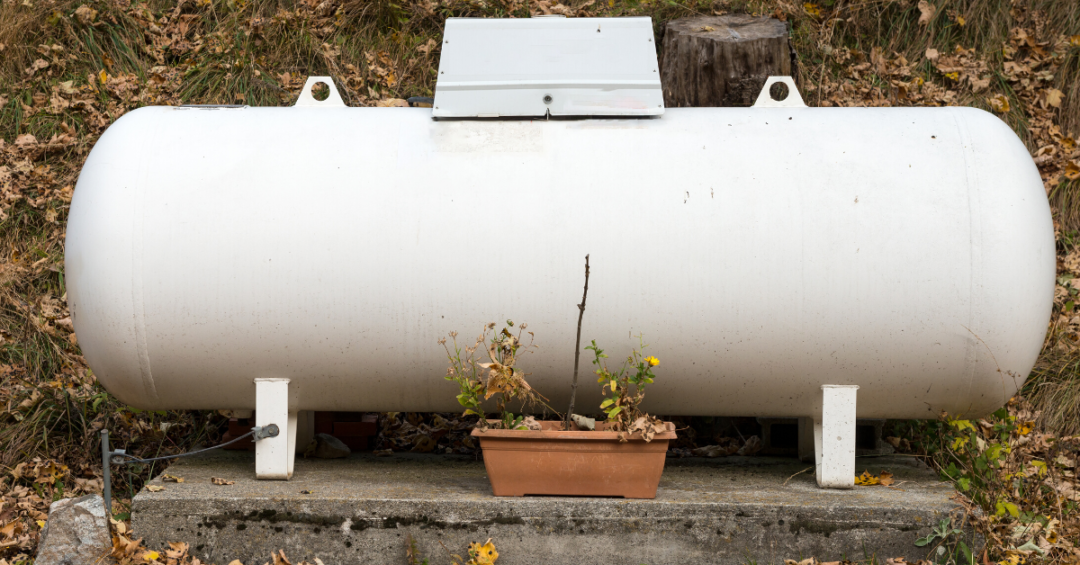
Oil
Typically you’ll either find a furnace or boiler system when it comes to oil heat. In short, there is a combustion chamber where the oil is ignited and then an exchanger that warmers the gases. 1. Furnaces use a fan or flower and vents to send the warm air throughout the home. With a 2. boiler you’ll likely see a pump pushes heat through pipes to radiators. Here’s smart touch energy again with more in-depth information on how oil heat works.
Electric
Typically found in older homes. Electric heaters or furnaces aren’t very cost-effective at least here in Ontario where our hydro costs are very expensive. You’ll need to be hooked up to the grid to have this type of heat (similar to natural gas). Typically no ductwork is found if the home was originally built with the intent of heating the home via electricity. So, in homes like this, you often find that they also don’t have A/C. It is, of course, possible to remove and install a natural gas or propane furnace but ductwork will need to be added which can be costly.
GeoThermal
There are several types of geothermal heating and cooling systems available. We won’t be going into each and every one. Here is a great guide if you’d like more in-depth details. In brief, pipes are buried into the ground below the freezing line. Both an ethanol-based fluid in the pipes and the heat from the earth are extracted and transported through these pipes into the home. The heat is then distributed throughout the home either by ducts or radiant heat.
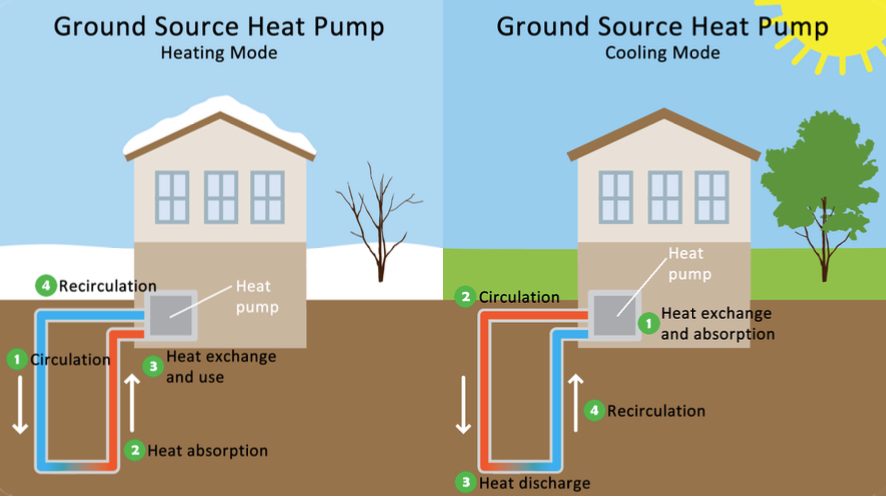
Credit: Geothermal Heating EPA
Natural Gas
Most of you know what these are all about so we won’t go into great detail here. If you live in a relatively modern home in an urban area you could find a house that is heated via a natural gas furnace.
When it comes to heating, we sometimes see a combination of some of the above in rural and country homes. For example, you might have an electric and propane combination. We often see a lot of homes in the country with electric or wood-burning fireplaces as well which help to heat your home.
WATER
Well
Depending on where your property is located and if there is adequate and safe groundwater, your country home will likely have a well. In short, a well is dug and a pump inserted that brings up the water from the ground and into your home. Having a useful well is great because you don’t have to pay for water. However, before you purchase a property it is essential that you have an inspector inspect the well and get well tests done to ensure it is safe for drinking and not contaminated. For more details click here.
Cistern
When your property does not have adequate or safe drinking water you’ll likely have a cistern. Essentially there is a holding tank that either collects rainwater or you can purchase the water yourself and have it trucked into your property. If you have ever seen the trucks with tanks on the back that say something like “Ed’s Water Haulage”, “Ed” is trucking water to someone who has a cistern that needs filling.
Municipal
There are country homes that, if not located too far outside of town, are or can be connected to the local water system. This makes things simple for those moving from the city to the countryside.
SEWER
Septic System
In the countryside, it is common to have what is called a septic sewer system. There are quite a few different types of septic sewer systems, but the most common one in Ontario is the septic holding tank combined with some type of absorption system such as a leaching bed, where liquids are filtered through and then absorbed back in the ground. The solids and sludge in the tank will require an outside service company to visit the property from time to time to suck out all the contents with what is basically a giant vacuum on the back of a big truck. There will be a cost for this service so it is something to budget for. As the property owner, the condition of this system will be your responsibility, so being careful with what you flush or dump down the drain will be something you will want to educate yourself on. You can read more here.
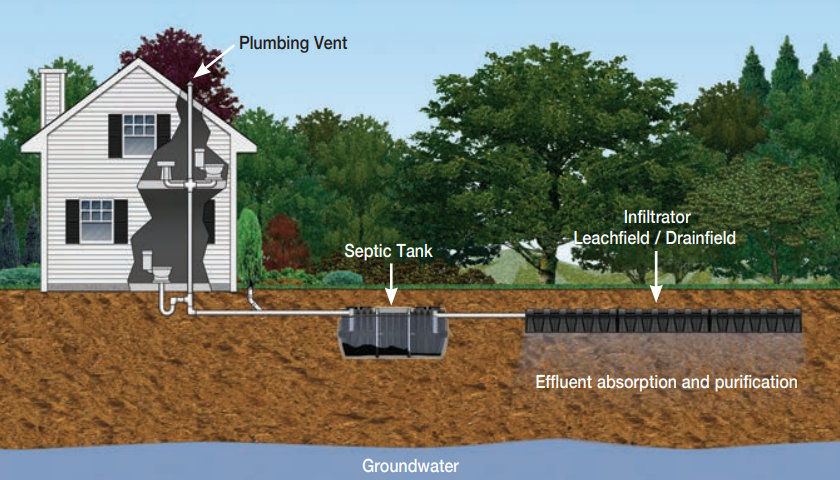
Municipal Sewer
Again, if the property is located close to city limits you might be lucky enough to be connected to the local sewer system meaning you don’t have to worry about maintaining or keeping an eye on your septic system. However, you are then connected to the grid.
Electricity
This system is pretty straight forward. Unless you are building a house that you have to fly in a bush plane to get to, you will most likely be connected to the electrical grid.
One potential opportunity though would be to supplement your electricity by creating your own! This will be site and location dependent. But if your plot is right, you may want to explore, solar and wind as possible systems to create some of your own power. If your property and systems are large enough you might even be able to obtain a contract with the Ontario government to sell electricity back to the grid. This would require a real cost to benefit analysis, as large scale systems are expensive and you are required to pay for the system yourself. Speaking to an expert will give you clarification on whether this is a viable option worth entertaining.
If you have any questions, reach out.
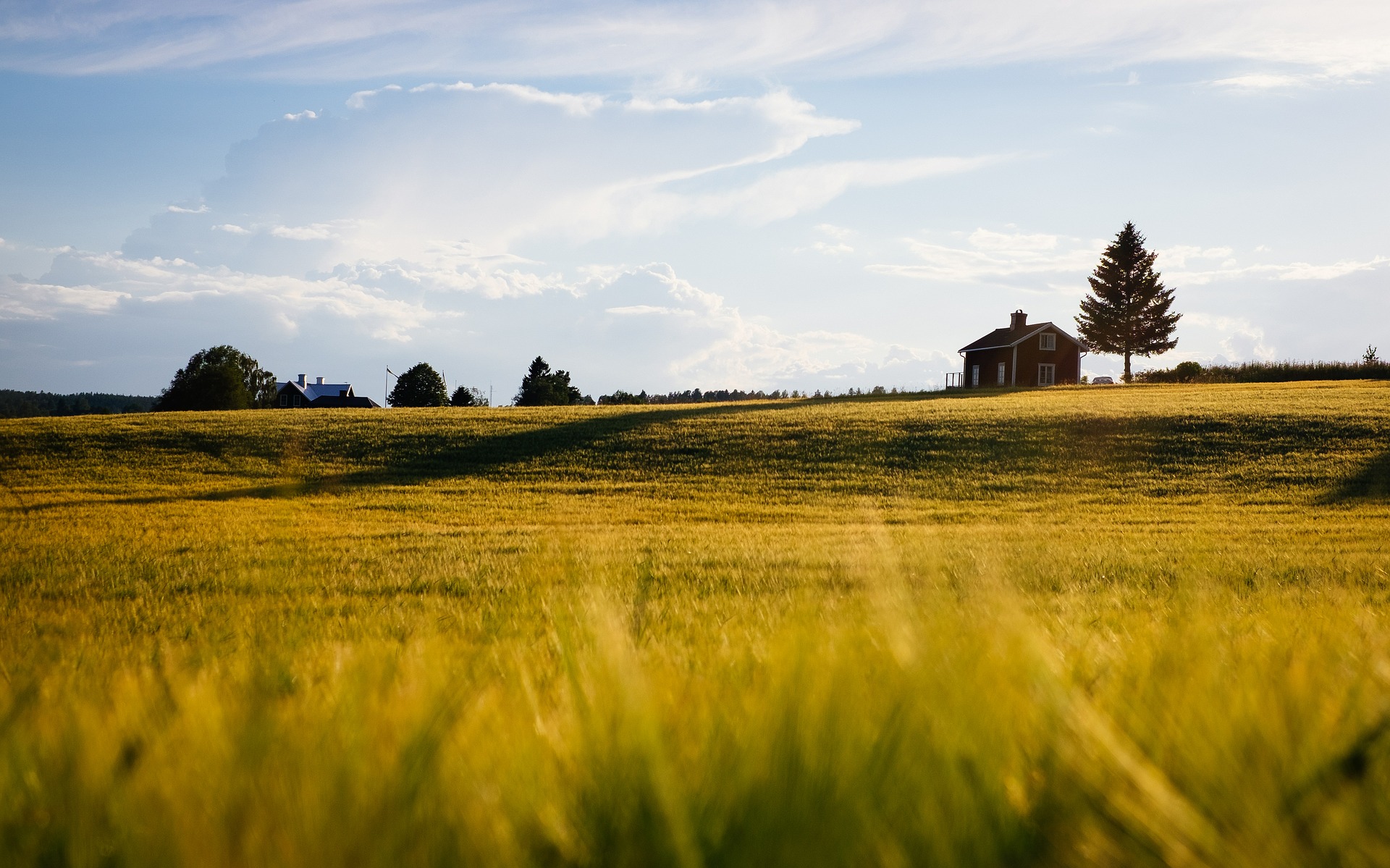
Avoid Buying Your Country Home Near Future Development
A longtime friend of mine has owned a farm on the border of Fonthill. A farm that has been in their family for generations.
Aside from a few country properties across from and neighboring them, they enjoy wide-open spaces in a wonderful rural setting.
Well, they did until a few years ago.
A farm down the road sold to a developer and because this particular area is not within the Greenbelt protections, the developer had no trouble changing the zoning and building a subdivision.
My friend and her husband had not seen this coming. Unfortunately, in most cases, it is extremely difficult to guarantee that your rural property will be safe from nearby development.
But, arming yourself with knowledge on the area you are buying in could help mitigate SOME of the risk.
Here are some tips:
Living in Protected Areas
Buying a country home in a protected area like the GreenBelt could thwart some of the risk of waking up to bulldozers on the property beside you.
Of course, this could change at any time but we hope not.
Properties protected under the Niagara Escarpment Commission or Oak Ridges Moraine Conservation Plan may provide you some protection as well.
Again, it is impossible to give you a guarantee that things will not change in the future. Take a look at this MAP showing over 600 requests and accompanying reasons to remove specific sections of land from the Greenbelt.
Now, bear in mind that living in these areas may also make it difficult to make changes to the home and property itself.
You will likely need permission and approval from conservation authorities and environmental protection agencies to add extensions, build new buildings and even remove trees on the property.
Contact the Ministry of Natural Resources and Forestry to get more information on types of property protections and how these can help you.
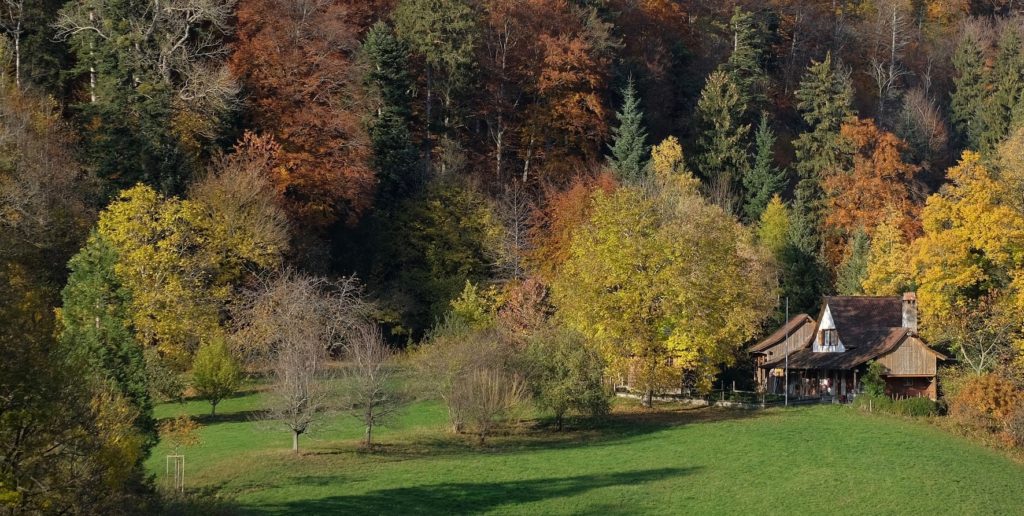
Connect With The Local Municipality
The local municipality should be able to confirm current land zoning, future use and planning allowances for your property of interest and the properties surrounding it.
Investigate to see if there are any applications to change the zoning of properties near your home of interest and go from there.
Be Wary of Buying near Major Highway Corridors
Towns along the 401 and 400 highways have been seeing a large amount of development over the last number of years.
The 401 towards London, in towns such as Woostock and Ingersoll, have seen growth in the number of subdivisions being built.
Interestingly, Stratford and St. Mary’s – two quaint towns set a little ways back from the highway – are seeing an increase in the rezoning of agricultural land on the outskirts of town as well. All to accommodate more housing developments.
New Techumseth, recently making the ‘Top 25 places to live in Canada’ list, is definitely one to watch. Most of the community is outside of the Greenbelt protection and only just a 1hr drive to Mississauga and 1hr30 minutes to downtown Toronto.
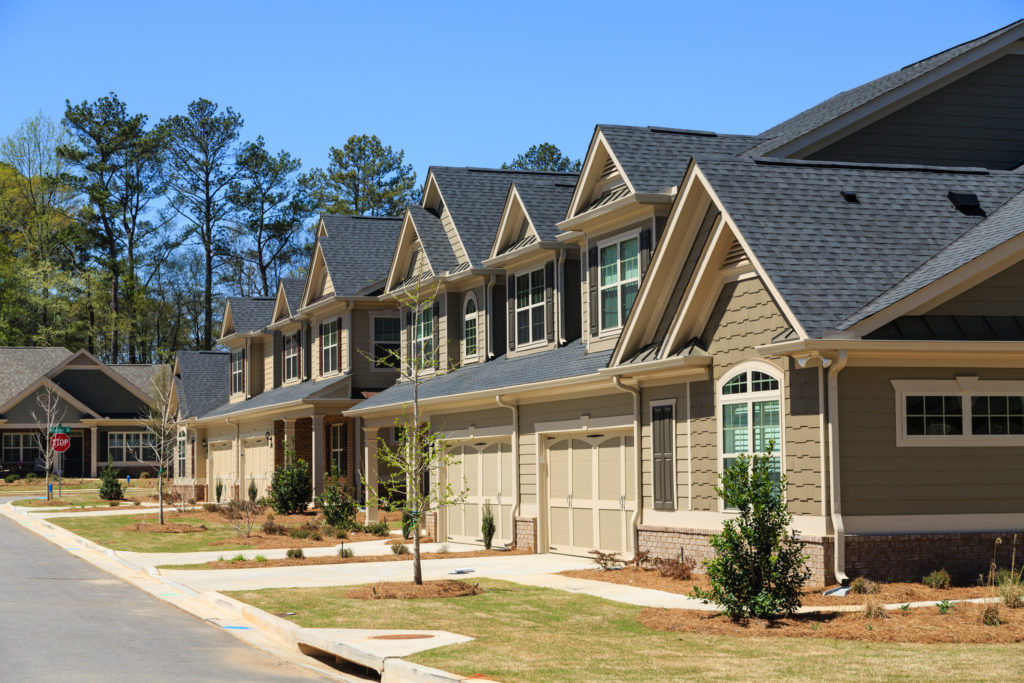
Be Wary of Buying Country Homes on The Edge of Town
This is best described with an example. We’ll use Niagara.
Generally, the Niagara Region has a tight plan when it comes to development.
The municipality has been consistent with protecting agricultural land and conservation areas from housing developments.
However, the 2013 Niagara’s GreenBelt Review Summary presented questions as to why First Street Louth and Fourth Avenue (where the new St Catharines General Hospital was built) were still included in the Greenbelt despite the growing amount of development surrounding these streets.
The Louth neighbourhood that encompasses these streets – just on the southeastern outskirts of St Catharines – is primarily dominated by agricultural properties, wineries and a number of country homes as well.
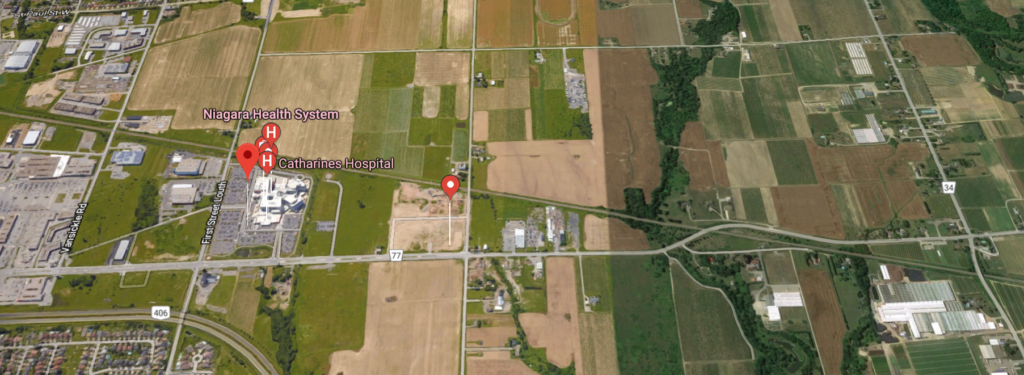
As far as I know, there are NO plans in place for developers to buy up the land here.
But without a crystal ball (and maybe even with one) it is tough to tell what could happen with so much development just a stone throws away from these streets.
Investigate The Growth Plan & Unprotected Lands.
The WhiteBelt includes sections of undeveloped land that lie between existing urban settlement and the greenbelt. This land is currently being used for agricultural and rural uses. See below in Red.
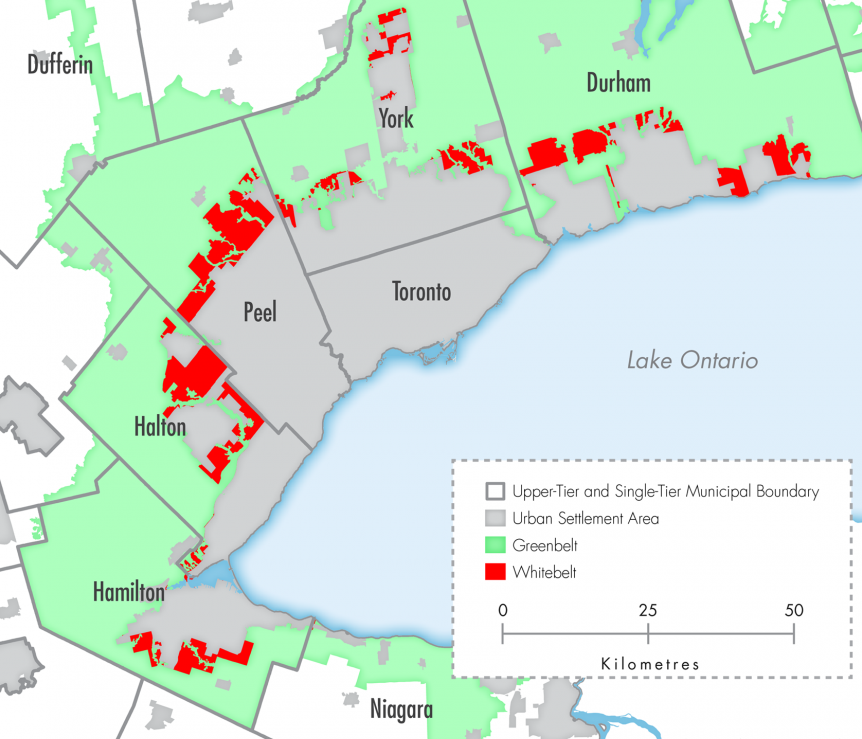
The Growth Plan 2017, is a strategic policy set out as a sort of blueprint for urban and economic growth around the Golden Horse Shoe. This is a Map excerpt from the 2017 Growth Plan document showing the potential use of the Whitebelt for urban growth and expansion.
Currently, these lands have not been designated for urban use but they do not have the protection of being in the Greenbelt either. If you are buying a country home within or bordering on the Whitebelt, investigate with municipalities, environmental agencies and conservation authorities to see what the future may hold for these properties.
It is easy to speculate about future development but difficult to get it exactly right 100% of the time. The tips given above are just that, tips. Many country properties are located within protected areas and frankly, the chance of having a subdivision spring up next door is relatively slim.
But it doesn’t hurt to do your due diligence before you buy any property.
Let these tips serve as a simple guide to help you decide where the best place to buy a country home might be for you.
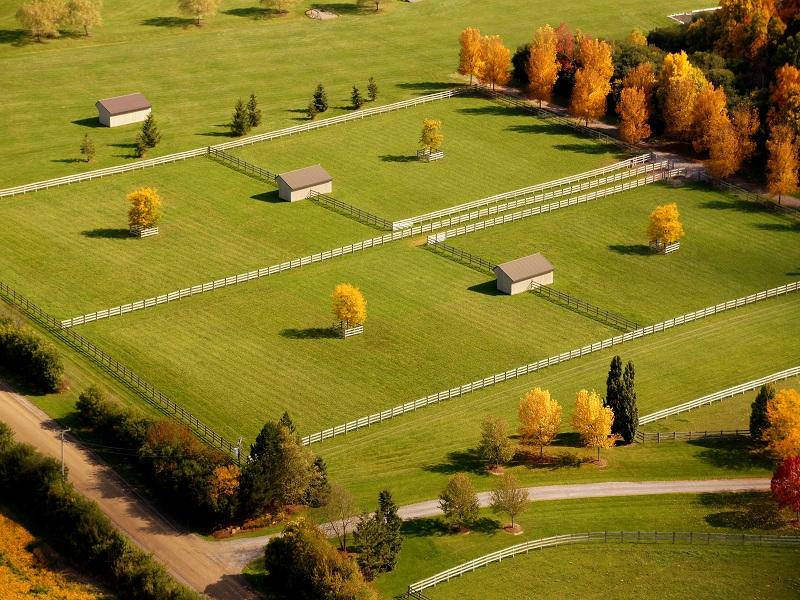
Ideal Horse Farm Layout For Every Acreage
The feeling of driving down a tree-lined driveway to arrive at a gorgeous, and well planned out equestrian facility is something special. Prim paddocks, organized buildings, and space that works best for both horse and rider is what most of us equestrians dream envision for our horse properties.
If you are thinking of building an equestrian facility from scratch then this is a must-read article! Here are the best Horse Farm Layout Examples we have found for smaller sized equestrian properties.
Can you ever have enough land when you own horses?
Technically, the more land you have, the more horses you could have… And potentially, the more land you have the more options you have for bigger barn space, more arenas (who doesn’t want a large sand ring, a large derby grass ring AND two indoors?), and possibly even a conditioning track?
If only it were that easy.
Land and money are both finite resources (for some of us), and so often times this means we have to work with what we have.
Here are a few great examples of various sized horse properties. They show great ways to be creative and make the most of the land you have.
5-Acre Horse Farm Layout
In today’s world (and real estate market), we see more and more people owning a modest equestrian facility and utilizing the land as best as they can.
If you’re looking for a cozy 5-acres for yourself and your horses, here is an excellent example.
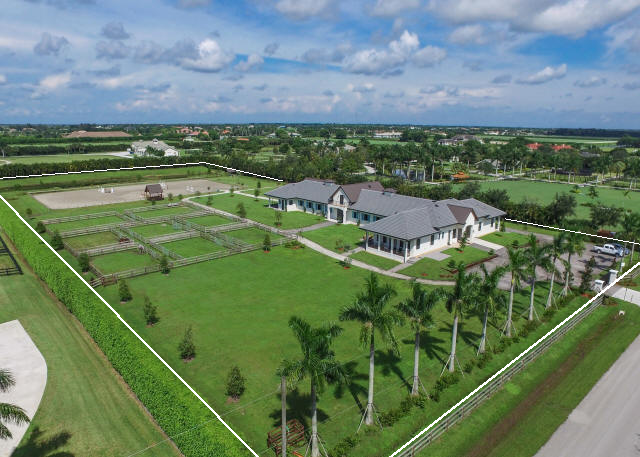
These images were taken from a horse farm in Wellington, Florida. You’ll notice the lack of indoor arena but you’ll also notice that there is more than enough space to put one in.
You have space enough for 6 individual paddocks and 2 group turnout paddocks. Where they currently have the home, I would instead have a 10-stall barn. The Indoor arena would then attach to the barn in the back. A modest home would fit neatly onto the green space to the left where you could overlook your paddocks.
10-Acre Horse Farm Layout
You might be able to tell from this example that we are back in Florida. 🙂 This luxurious facility houses 14 horses, offering two beautiful, big outdoor arenas, a big home, large paddocks and a hot walker. There is also staff housing located on the property.
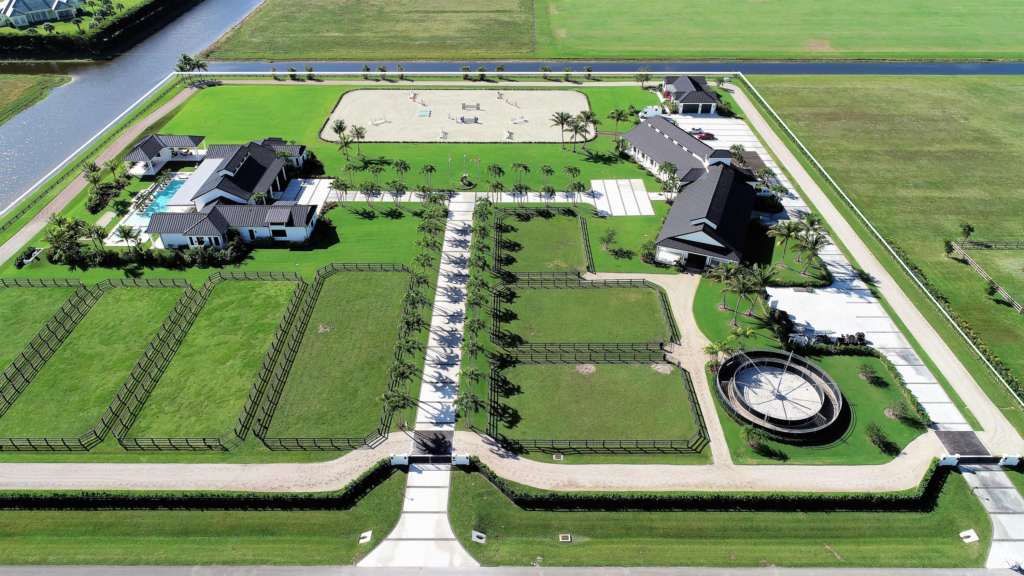
There is no indoor arena on this property either but with a little bit of re-configuration, you could easily put in an indoor arena. Besides, the house is a little grand for my taste and with a smaller home, you would have a little more land to play with.
The thing I truly LOVE about this layout is the track that traces around the property – perfect for cooling out the horses after a hard workout.
20-Acre Horse Farm Layout
With 20 acres of land, you have space enough for a large and grand equestrian facility.
The property example below is currently for sale in the Hamptons, curtesy of Saunders Realty. You can marvel at the entire property here. This is definitely a grand estate with a hefty price tag to boot.
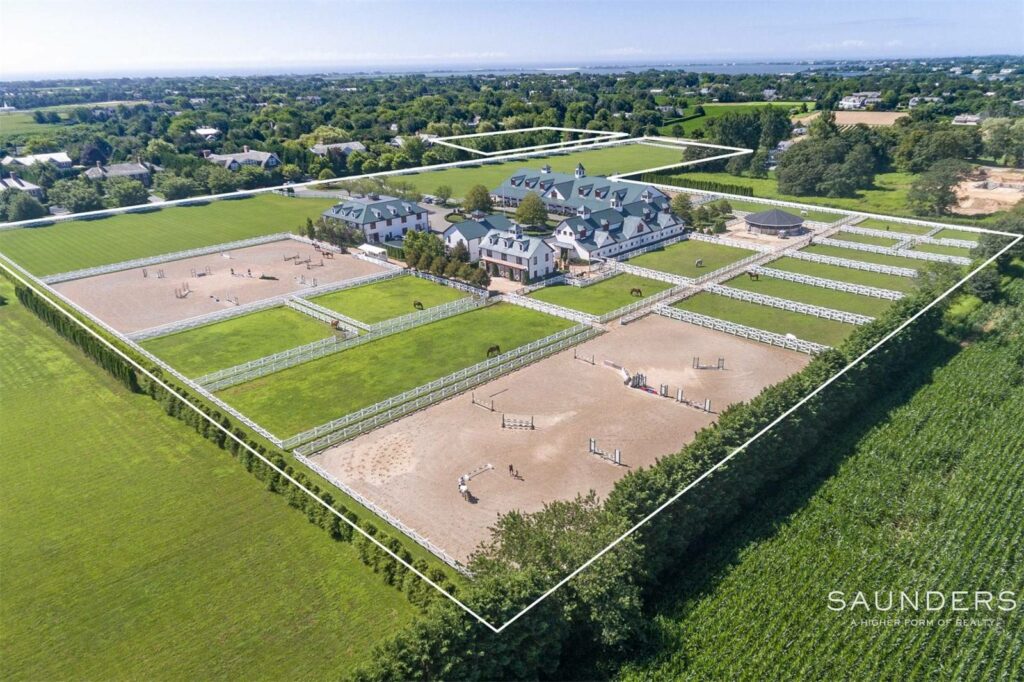
Here you have a very neatly laid out property. An indoor arena and three outdoor arenas (2 sand, 1 grass). There are two residences on the property. One for the owner and the other is staff housing. 14 paddocks (if well managed) offer more than enough space for the 27 horses that the barn accommodates.
With this size of property, I would probably turn one of those sand rings into a grass ring and use the front two fields to produce my own hay.
50-Acre Horse Farm
With 50 Acres there isn’t much you can’t do in terms of layout.
I am using the boarding facility Shenandoah Equestrian in Burlington as an excellent example of a well-utilized and well laid out 50-acre horse farm.
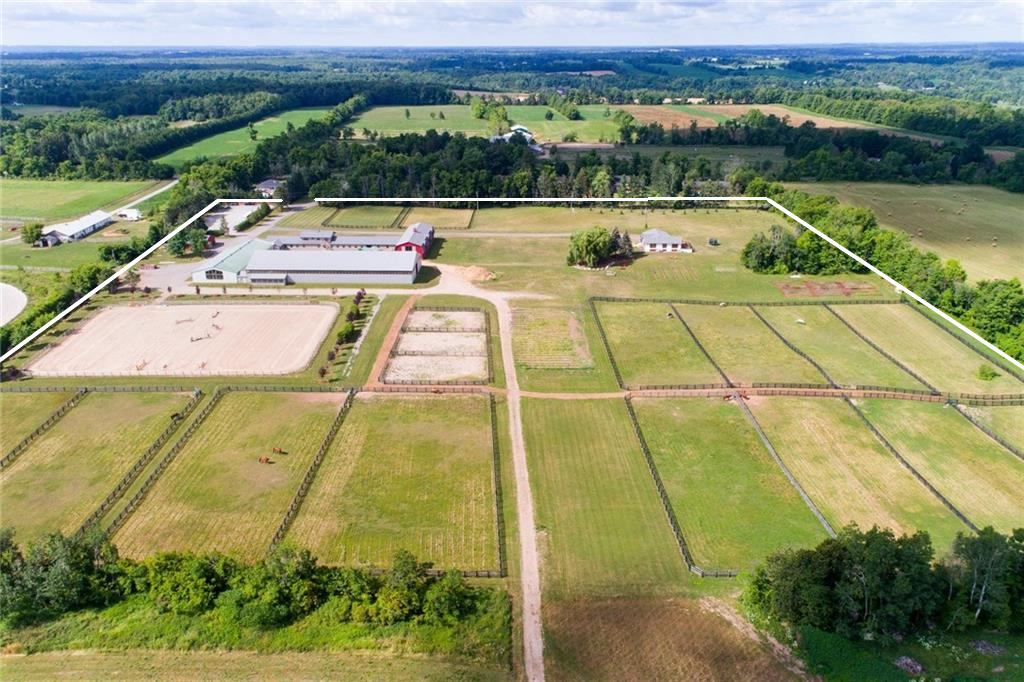
This property houses up to 30 horses, offers tons of paddock space and more than enough riding arenas – with 2 indoors and a large outdoor sand ring. There is also a large home on the property as well as a hay field and still a lot of room to spare.
We hope these examples of smaller equestrian properties will help you on your journey to designing your own layout for your equestrian property.
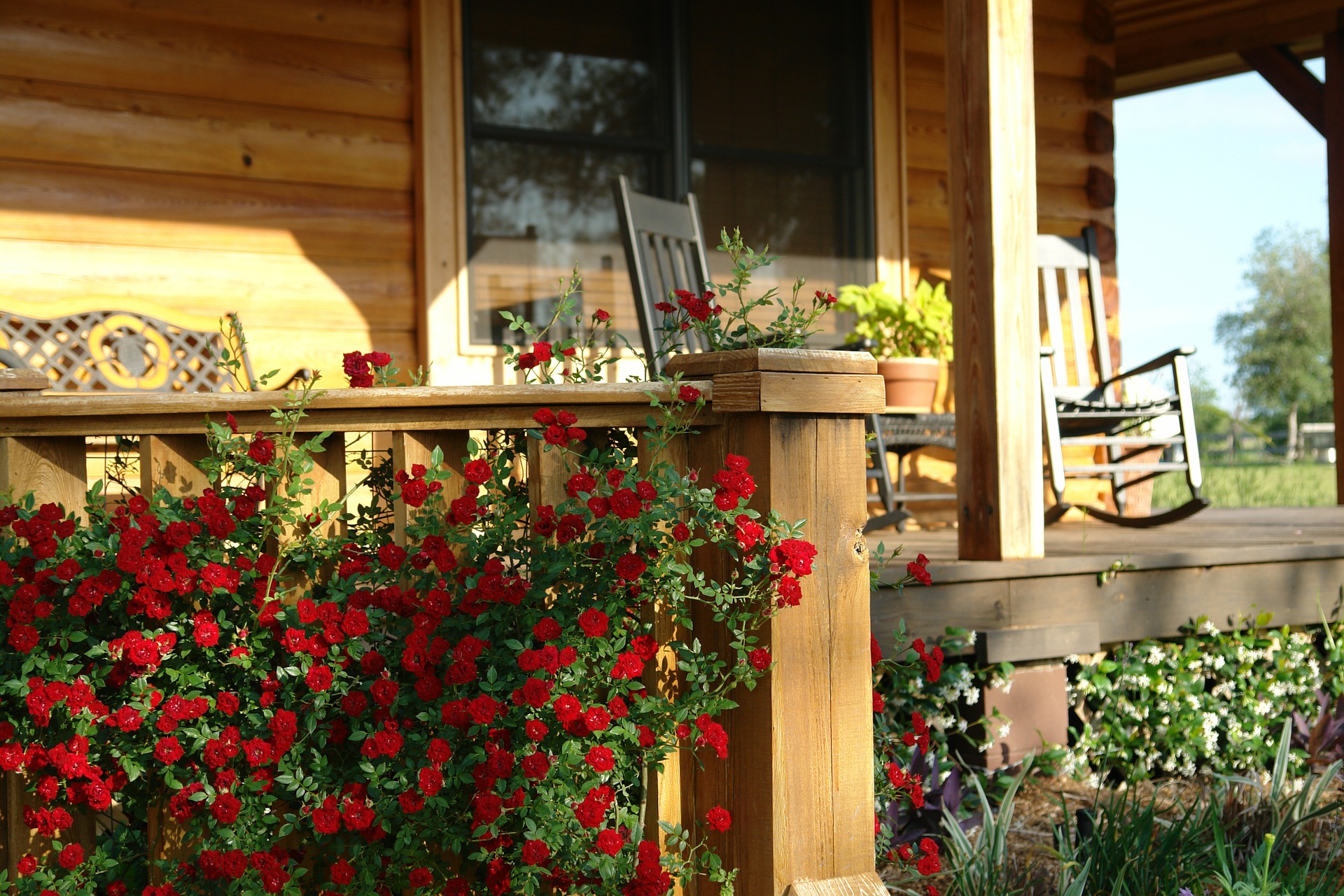
Buying A Country Home in Niagara
What are the best locations for buying a country home in the Niagara Region?
If you are looking for a country home in the Niagara Region, look no further than our TOP 5 favorite countryside areas in Niagara.
Living in the Niagara Region is wonderful. If you like welcoming communities, rich natural landscapes and the odd glass of wine, this is the place for you.
To help you get your bearings on the countryside and rural areas in Niagara, have a look at this map:
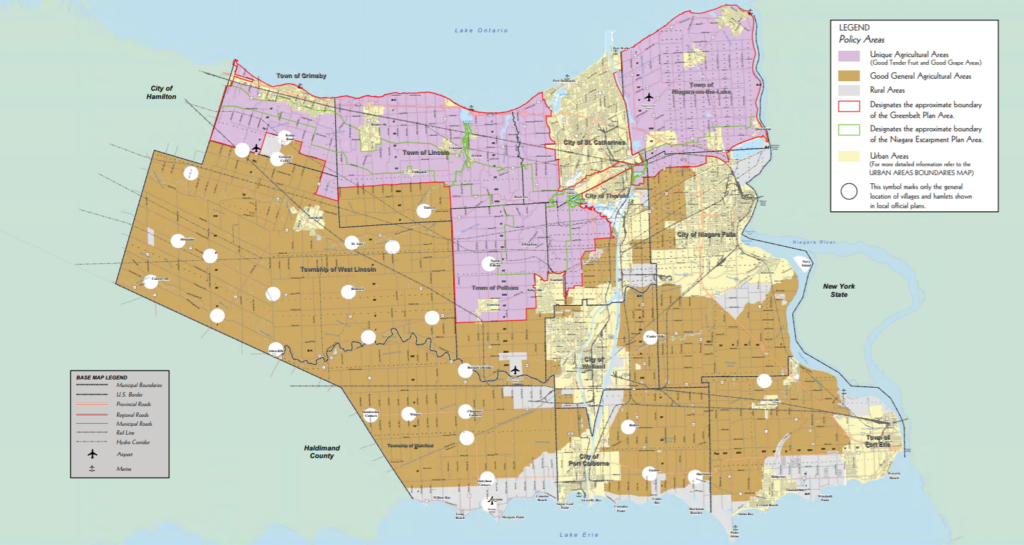
1. Effingham, Pelham
I know I’ve said this before but I adore the Pelham area. And truthfully, anywhere in the Pelham area makes for ideal country living.
Effingham is the most northern part of Pelham and encompasses a portion of both the scenic Short Hills and Saint John’s Conservation area.
Almost daily I drive along Effingham Street and get to marvel at the private estates and modest country homes tucked away on treed lots. Any road you take off of this road is sure to impress with charming properties and country retreats.
Effingham is also a horsey community.
If you decide to explore Effingham you will find picturesque paddocks and little barns along many roads in this community.
You won’t feel secluded living in the Effingham countryside but you are sure to experience a chic country lifestyle.
Fonthill would be your closest community for shopping, restaurants and other amenities.
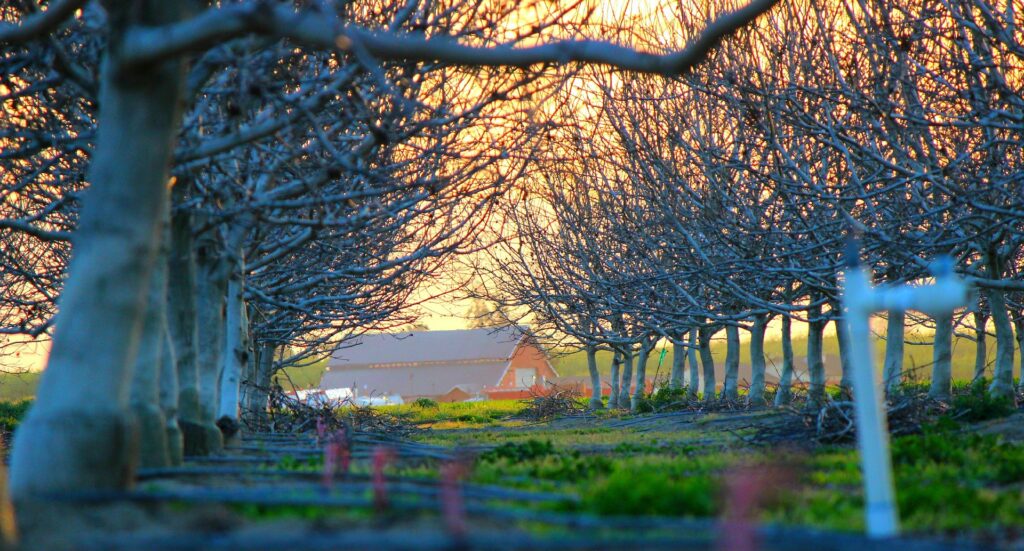
Perhaps currently the most sought after area in the Niagara Region, this community sits atop the wonderful Niagara Escarpment.
Located within the GreenBelt, this is a community surrounded by beauty and natural landscapes. Ideal for those of you that enjoy an active lifestyle as the Bruce Trail winds along the north side of Ridge Road.
You can find a range of home styles here. Century homes, sprawling bungalows, grand and private estates, private farms and quaint country style homes set on large lots.
There aren’t many properties currently listed, making this an exclusive spot for country living.
3. Saint David’s, Niagara On The Lake
A number of the communities in Niagara-On-The-Lake are seeing a creeping up of residential development in their core areas. It is unfortunate but a reality facing many areas in Ontario.
And Saint David’s is no exception.
But along the outskirts of this historic community, you can find some of the best rural living in the region.
You might be lucky enough to get your hands on a heritage home but if not, there are a number of other country properties to choose from.
Quintessential bed and breakfasts, endearing country escapes and stylish estates are just a few types of homes you can expect to see.
With historic reverence, a rich culture and located just a stone throw away from renowned wineries, St David’s is an ideal community to enjoy country living.
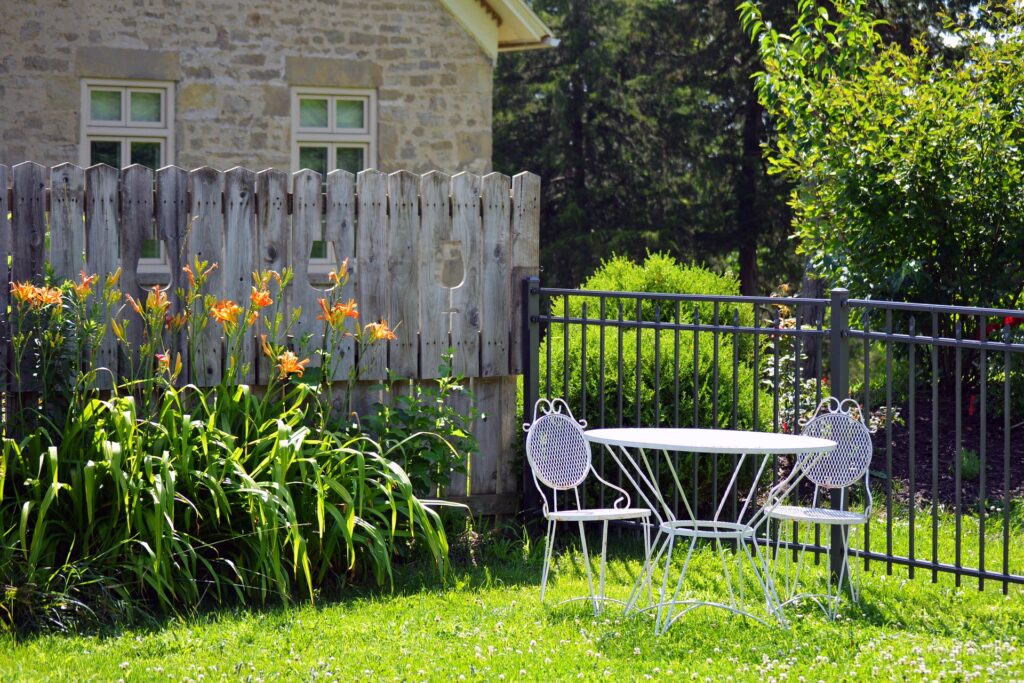
4. Jordan, Lincoln
A quaint and charming community bordered between Beamsville to the west and the Louth area of St. Catharines to the east.
Jordan is surrounded by beautiful farms, orchards, vineyards and country homes.
At the village core, you will find a voguish setting; boutique stores, art galleries and excellent restaurants.
If you are just visiting, be sure to check out the cozy and chic accommodations on offer in the Jordan Village or enjoy a day at the spa before heading out on a picturesque hike.
Although there are many beautiful country homes here, Jordan village is a small community and not many properties come up for sale here.
Making this another exclusive countryside community in Niagara.
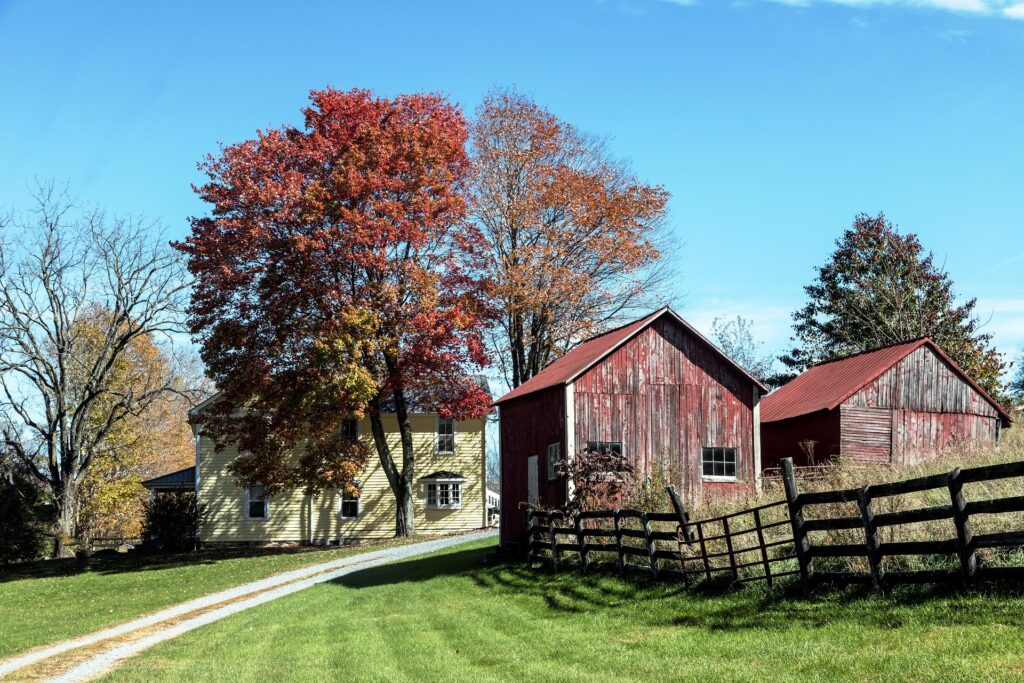
If you truly want to live the rural lifestyle, where you aren’t too close to your neighbours and the nearest grocery store is in the next town over then Wainfleet might be the spot for you.
Waintfleet is unique in that it is home to both large stretches of agricultural land and, to the south, lovely lake beaches.
Waintfleet is not connected to municipal sewer or water services – developed properties typically have a septic system and private well or cistern. You can read more about rural living on the Waintfleet website here.
In terms of housing, you can find newer homes as well as older farmhouses.
If you are ready for a life of quiet contemplation and peaceful surroundings – and understand the hard work that can come with living in a rural community – then Wainfleet might be just the place for you.
Parts of this article were adapted from our Niagara website here.
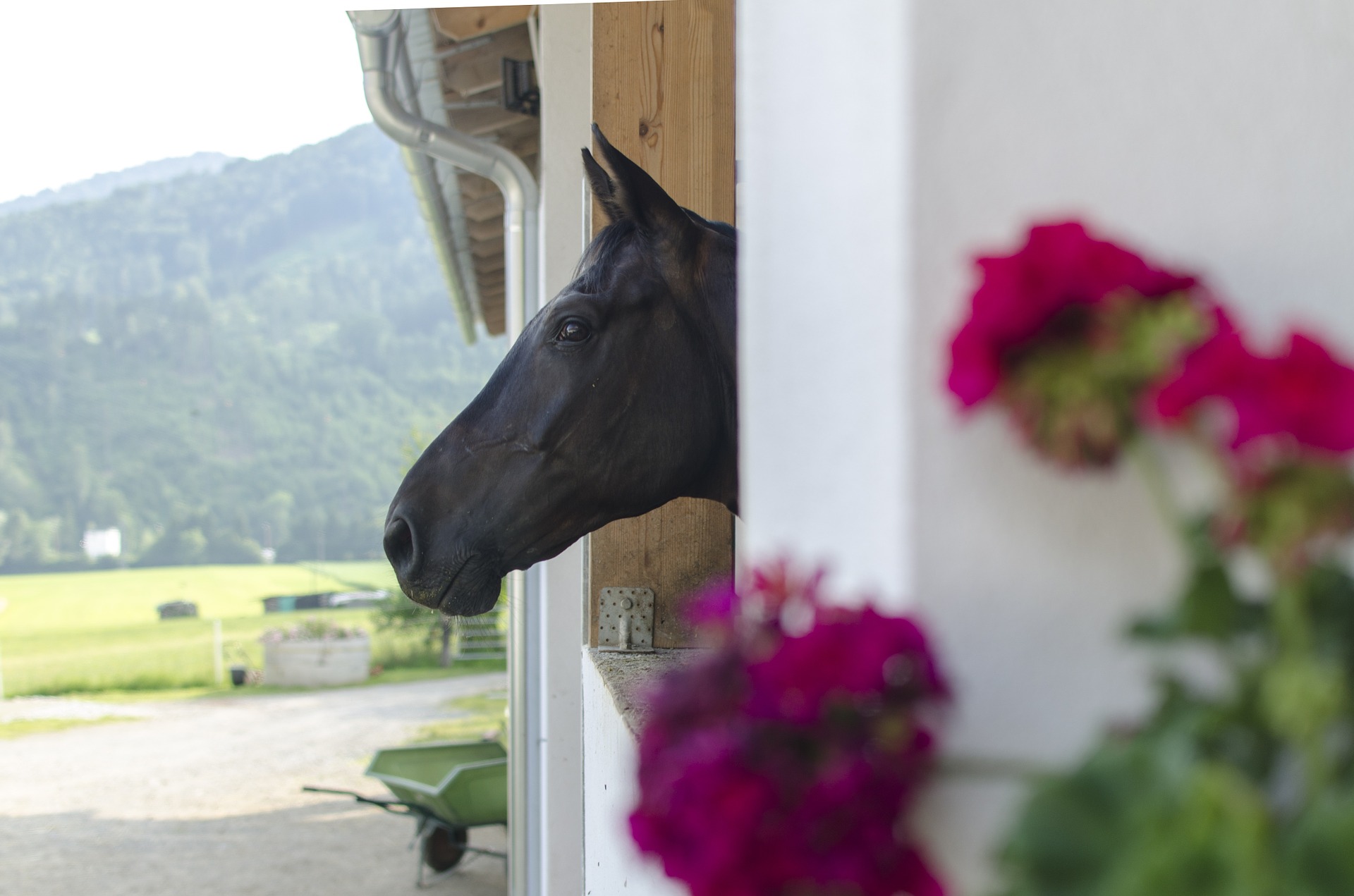
Starting a Successful Horse Boarding Business
JP and I have both worked at, boarded at and ridden at many different barns over the years. Picking up ideas about what seems to work and what doesn’t.
1. The Type of Barn
Small but high-end barns. A niche product.
Typically this is a private facility of just 12-20 stalls. Focusing primarily on a state of the art facility and providing top quality care. For this premier facility, one would be asking a high monthly board fee of between $1,500 and $2,000/ month.
All depending, of course, on what type of facility you have and what services you offer. Typically these barns are highly individualized to horses and owner needs. The more expensive barns will usually offer training as part of that board.
The Facility –
The barn usually sets itself apart from every other barn. A truly top-notch haven for horses and their owners.
Training & Lessons –
Whether you include these in your board is entirely up to you and the numbers you need to make the venture work. At this level of board generally, some type of training is included.
It will also depend on whether you have an outside trainer coming in whom you might have to pay and so on.
A very popular option is to allow in outside coaches to train their client/s that may board at your facility. A tough one for most barn owners that are also trainers but it provides variety to clients and opens up the doors to more boarders.
Staff –
We cannot stress how important it is to have qualified and educated staff. If you are asking top-tier board, you must offer a high standard of care. At higher rates, these barns often provide full groom services as well.
On top of the normal booting, blanketing and picking feet, services can include bathing, clipping, worming, grooming, laundry, lunging, grazing and tack cleaning.
A select few, full-service barns will have a boarders horse tacked and ready to go when they arrive.
Turn-Out –
Safe, consistent and carefully managed.
Many people recommend 1 acre per horse for grazing, but this is not always feasible. You can have smaller sized paddocks but they will need to be managed well. Most of the high-end barns will offer individual turnout for all horses.
Arenas –
Typically, high-end barns have at least one good-sized indoor arena – 80 x 200 or 220. Most have two decent sized outdoor arenas as well. The sand footing in these arenas should be top quality (ideally a sand and fiber mix).
Check out Footing First for excellent footing options.
Value Added Services –
These may include:
• A small fitness track
• Hacking opportunities
• On-site laundry facilities
• Lunging arena
• Security and surveillance (including in-stall wed-cams)
• On-site live in management
• Sprinkler systems
• One site showers
• Heating lamps
• Hand Walking and Grazing
• Tack Cleaning
It is important to create an atmosphere of luxury and high-quality care if you are asking this level of board.
2. Owning The Right Investment
It goes without saying that you need the right property to run a successful boarding facility.
But more than that it is essential to look at your property as a real estate investment. One that can “work” for you outside of the boarding facility.
Put very simply, over time your property should appreciate – giving you access to equity that can be used towards improving your current facility or put towards other investments.
Buying the Property –
Whether you buy a facility or buy and build, the following three must be in place.
A property in a prime (or at least good) location with the right zoning to allow for a horse boarding operation.
Secondly, land quality must be good, with good soil.
And thirdly, buy a property that has been well cared for by its current owners.
It is difficult and costly to run a horse boarding facility. Owning a property with additional income options (like a secondary residence to rent out or excess fields that can be leased to a farmer) would be a bonus.
This article goes into greater detail about how to make the most of equestrian property real estate investment.
If you own the property –
Take care of your investment. Look after and maintain buildings, homes and the land. Over-grazed fields and rundown buildings don’t help appreciation. Nor do they attract good boarders.
3. Making Sure The Numbers Work
People get into this business and don’t truly realize how costly it can be.
If you’ve never run a boarding facility before, you may not know exactly what things are going to cost.
Our recommendation is to get extremely detail oriented here. Find out what expenses are going to be on a monthly basis. Get all of your financial ducks in a row.
The Expenses –
If you have been in the horse business for some time, you’ll know there is a long list of expenses that come with owning a horse, let alone a barn with multiple horses.
Monthly Expenses –
These will include (and definitely not be limited to):
• Mortgage or lease payments
• Feed
• Hay (ideally your property can be hayed, but costs for the tractor and bailing equipment will need to be accounted for).
• Shavings
• Utilities
• Salaries / Wages for staff
• Regular maintenance of the facility and machinery
• Insurance (if running a facility it will be commercial insurance)
• Taxes (income and property)
• Waste removal required
• Security
And of course, there are the expenses required for your own horse/s as well.
Start-Up Expenses –
• Down payment
• Any updates or renovations
• Improving the footing
• Machinery and equipment
• Seeding any paddocks that need new grass
• Fencing
• Security Installations
• Advertising (if you don’t have current clients to fill up the stalls).
Contingency Fund –
You will want to have some sort of back up ‘cash’ for big fixes, emergencies and general upkeep of the property. You may also need this if you have a high turnover of clients to carry empty stalls (which ideally you shouldn’t have).
The Income –
Although boarding may be your primary source of income, you may need or want to offer other services.
In addition to board, you may offer training, lessons, horse sales, clinics and off-property schooling for guests. It will depend on your preference, your discipline and what numbers you need to make to cover, and ideally exceed your expenses.
If you are lucky enough to own a property that has a second home, consider renting it out for additional income.
Here are six creative ideas to generate a little extra income on your horse farm.
4. Having The Right Contacts
Good and trustworthy connections can be hard to come by.
If you are starting an equestrian business, you should already have a ton of experience in the horse industry and have made many connections along the way.
Connecting the right people to your new clients could go a long way with building lasting relationships and add value to their time at your barn.
Farriers, Massage Therapists, Vets, Chiropractors, Saddle Fitters and the like. These experts all help in maintaining the health and happiness of the horses.
Final Thoughts
Taking care of other people’s horse is a large responsibility. One that cannot be underestimated. You may love horses and people but owning a boarding or training barn will test this love.
You can’t please everyone, but if you do right by the horses you’ll keep on the right path and hopefully make a success out of your passion for the equestrian sport.
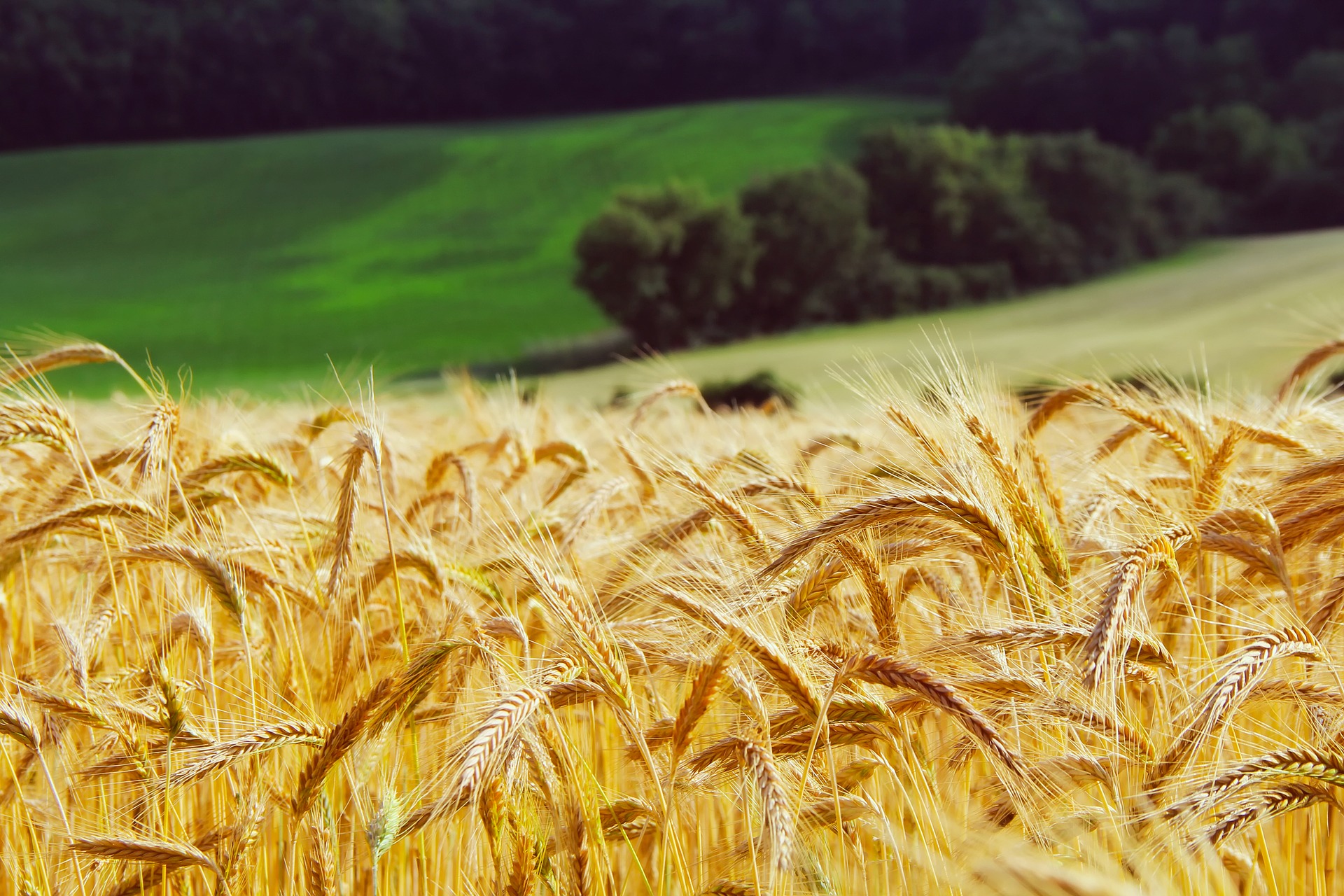
Wealth Preservation with Canadian Farmland
The possibility of wealth preservation with Canadian Farmland.
Most seasoned investors are familiar with Commercial real estate as a way to preserve capital after they have already made it in business or have experienced years of growth with smaller real estate investments. Perhaps the time comes to consolidate equity into fewer but larger properties.
Commercial real estate is still a fairly active investment, where you have to think about improving management, improving the tenant profile, upgrading the buildings and so on. There is nothing wrong with this…but some investors out there might be wondering if there is a tangible real estate asset that will preserve capital in a similar way but that requires less active involvement.
Canadian Farmland could be an attractive alternative. Ok let’s jump in…boots first! 🙂
The “Dirt” on the Dirt
We might as well get this out of the way right off the bat…..nothing is perfect.
As you may or may not know, financing on Commercial real estate can be brutal, but Farm Land financing might be worse. For instance, if it is just farmland without a house on it, and you yourself are not a farmer…..well, there aren’t really any financing options. So this would then literally be a place to park cash. You will need to look at this type of investment as you would a stock, bond or some offer paper asset instrument, except of course, that this is real and tangible. The draw to farmland is that, like any other forms of real estate, it doesn’t vanish into thin air with the click of a button!
This is not a cash flow play, income on farmland is low.
So if you are expecting it to cash flow like a student rental, it won’t! This is a Steady Eddy form of investment that has extremely low volatility.
There are ways to increase cash flow of course. For example, by buying a piece of farmland with a house and out-buildings on the property that you can rent out for additional income. In this scenario, you should be able to finance the house and a limited number of acres to increase your ROI, paying the balance of the land purchased in cash. Or you could enter into higher risk/return rental agreements that include a crop share arrangement. This allows you to share in the fruits of the farmers’ labour, but you’ll also share in the down years as well. Having said that though, most rented farmland is just a straight cash rental amount – just like a house – and that is what we will be basing our overview on in this article.
Here is another perspective to consider. With commercial real estate, there can be booms and busts, vacancies, oversupply in the market and so on, just like rental housing. With farmland, what is out there is out there, they aren’t making any more of it! In fact, we are losing farmland to development as our population grows and cities continue to expand.
Building a Case for Buying Farmland
Canada has 70 Million Hectares of Agricultural land and punches well above its weight in net cereal crops and meat exports compared to other producing countries due to our relatively small population. Now take note, the amount of Canadian farmland has not changed since the 1950’s, but the average Canadian Farm size has. There has been a lot more consolidation of farms, giving us a larger average farm size compared to the U.S.
With larger farms comes an increase in net investment into the farms. In fact, net investment has gone up over 162% in the last 20-30 years. This means Canadian farms are running more advanced, higher tech operations and practices which is fuelling higher profits and revenues compared to other producing countries.
Just like in our commercial and residential markets, Canada Farmland is certainly appealing to foreign investors. Here are some reasons why:
- Canada has a global reputation for being a safe place to invest. Even with the correction in 2008, Canada survived very well compared to other OECD (Organization for Economic Co-operation and Development) countries.
- Canada is also considered a safe place and has none of the sovereign risks when compared to other countries. Corruption perceptions are very low with our strong courts and property rights systems.
- We have a well-established infrastructure network for roads and rail, with access to the U.S and also coastal ports on either side of the country.
- Because of our soil types and climate, only about 2% of our arable land requires irrigation, compared to 15 – 17% in the US and 40% in China. And we also have ample supplies of water if we need it! Because Canadian farmland requires less irrigation, we have much fewer problems with soil degradation, and while this is awkward to write, Canada stands to become even more wet with climate change. Nature (scientific journal) is already predicting that Canadian Agricultural yields stand to increase with climate change in parts of the country and is one of the only counties to do so
The Numbers / Risk Return
You can look back at 60 years of history on Canadian Farmland returns and find equity-like returns, similar to those of stocks but with much less volatility.
You will find 7-8% average return on appreciation with 2-3% (of land value) net lease income for an average of about 10% total return per year – all with a standard deviation of only 8%. Compare that with Canadian bonds….8% return and 10% standard deviation over the same period of time. On average, Canadian stocks returned about 11% but had a standard deviation of 16-17%! Remember how I said Canadian Farm Land was a “Steady Eddy” investment?
Farmland has also been a great hedge against inflation. Farmland values have increased as food prices have increased, and as a general rule in times of inflation food prices have increased more than the rest of the economy. And interestingly during inflationary periods farmland returns have increased almost at the same rate as treasury bills.
Even in times of deflationary pressure in other parts of the economy food prices remain high – and with food shortages and population growth – the price of food will likely continue to rise and so it seems, will the price of the land that grows it!
Opportunity
The average price per acre of US farmland is $3140 for 2018, compared to the average Canadian price of $3111 in 2018.
Coupled with all the positives in our farming industry, Canadian Farmland is a very attractive investment and stands to increase in the decades to come.
Certainly, with these types fundamentals foreign interest and investment will be strong….so get while the getting is good!
“Wherever your day takes you and however it ends, chances are it began with a farmer” 🙂
* Statistics and other information adapted from Bonnefield. For more in-depth information on farmland investing, please visit them here.

6 Ways To Make The Most Of Your Equestrian Property Investment
No matter what you are planning to use your equestrian property for – be it a private facility, a training barn or a modest property for a couple of retired horses – equestrian properties don’t come cheap.
It is essential to look at any equestrian property as a long-term investment.
Buy a good property, in a good location, that has been well maintained by its current owners. You can always replace or rebuild infrastructure but improving the location and quality of the land is next to impossible.
1. Land Quality
This is probably the most important aspect of the equestrian property.
Changing the soil, for instance, is not feasible. Clay, for example, is fine but not necessarily ideal for equestrian properties.
Weedy paddocks that have been overgrazed can take some time and money to get back to a suitable condition. It is important to buy a property where turn-out has been managed correctly, and even more so that you manage the paddocks correctly once you become the owner.
2. Build Up Equity
Ideally, You want a property that will, on some level, appreciate. Hopefully then, giving you access to built-up equity that you can use towards other investments or improving current ones.
To build up equity, it is important to purchase a property in a good location where the land has been well cared for.
From this foundation, you can add value to the land with new buildings and/or updates.
3. Future Sale
Look at the potential future use of the property.
Think about what other income possibilities the property may have for you down the road – could you one day host shows on the property, is
Think also about how future investors might look at the property 10 – 20 years down the road if you ever decided to sell. You and your realtor should talk to the municipality and get an understanding of what is happening in surrounding areas that could affect your property value in the future (positively or negatively).
4. Land Severance Possibilities
Severing the land could be an option as well under the right circumstances. However, if you are in the Greenbelt (which most equestrian properties are) you might be out of luck on this one.
On
5. Cash Flow
If you are hoping to run a boarding or training facility, you’ll want to have all your numbers figured out before diving in.
Expenses, Incomes,
Owning a property that allows you to make your own hay is ideal. Even if you can only support it for a portion of the year. It goes a long way with future sales.
Here’s a great article to get you started on the financials and planning of your horse boarding venture.
6. Take Care of Your Property
I have mentioned this many times because it is essential to equestrian property success.
Look after your land and your buildings. Maintain the property and the buildings as much as possible. If the time comes where you want or need to sell, a well cared for property is going to fetch top-value.
Did we miss anything? Let us know how you look at your equestrian property as an investment.
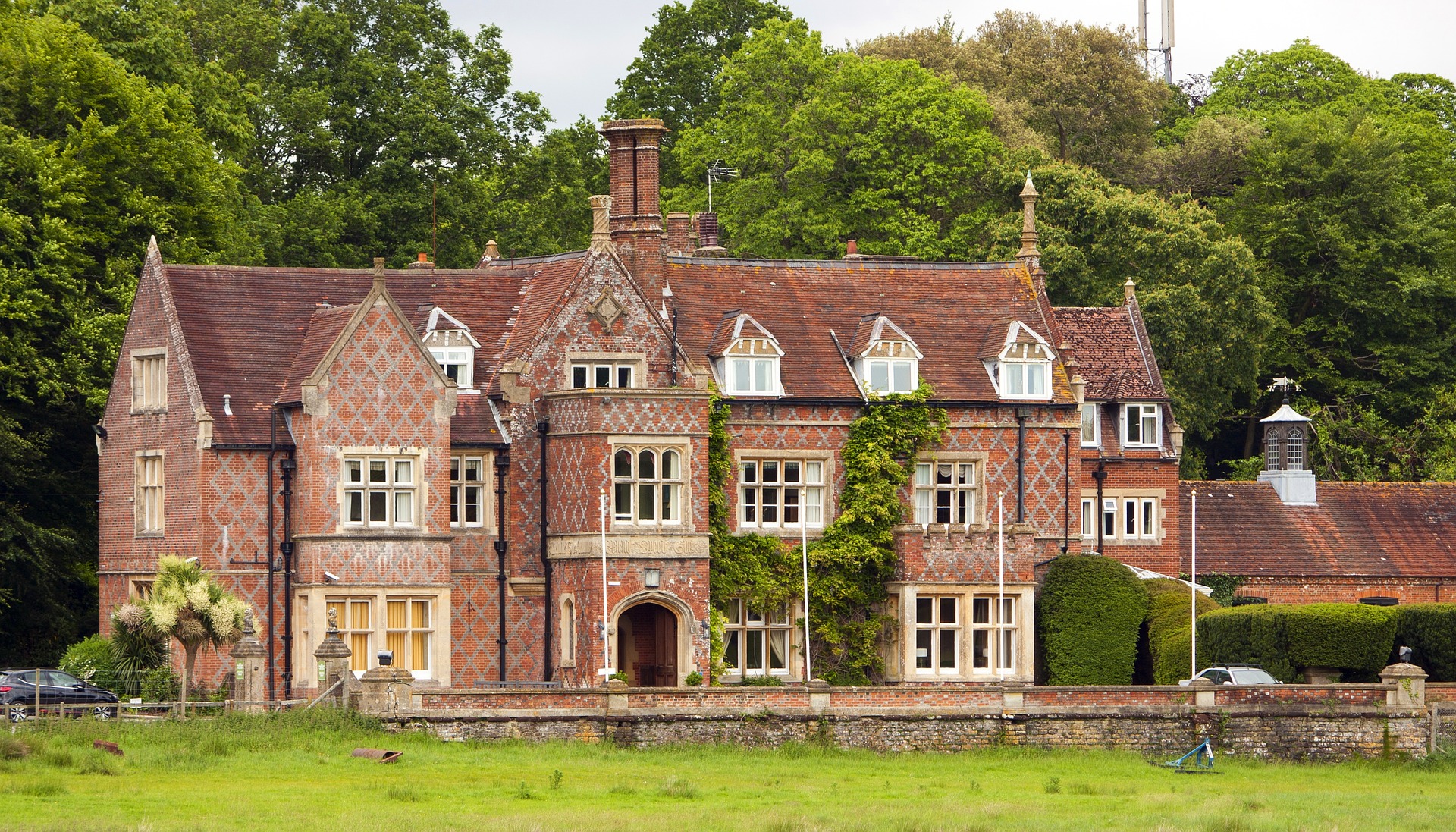
6 Mistakes To Avoid When Buying & Restoring Old Homes
Here are the 6 most common mistakes people make when they decide to buy and restore old century homes and farmhouses.
They Don’t Have A Serious Plan of Action
Often times people get swept away by the romance of living in an old home. I don’t blame them. Gorgeous trim, unique character and rooms with stories to tell.
But this is why restoring older homes fall apart. The logic is missing.
One needs to have a solid plan in place.
Your first step is to put together a team of architects, contractors, realtors, home inspectors and mortgage brokers who understand your vision for the property.
From there they can help you come up with timelines, budgets, financing options and so forth.

They Don’t Think Of The Purchase as an Investment
I know we talk about this a lot here at Land & Title but it is only because it is very important.
Sure, the property needs to make sense for you now. But it also needs to make sense for the future. Be it your first house or your forever home, thinking of the home from an investment perspective is the right thing to do.
The investment plan will, of course, depend on your plans. There will be different nuances and caveats to your investment plan depending on how long you plan to hold the property.
But here are some ways to think of the investment that can apply to everyone:
- Pick a property in a great location on a great lot. One that will appreciate.
- Don’t bite off more than you can chew. By that I mean make sure you can completely afford this restoration project. It would be a disaster to spend money on buying the home, renovating half of it, only to run out of funds and have to get rid of it at whatever someone else is willing to pay.
- If your renovations are too unique, resale options will be limited. For example: Renovating an old church. As beautiful as they can be, if your hope is to turn around and sell the property down the road this may be a bit too unique for most home buyers.
- Think about both the current and future opportunities for the property that either you or the next buyer can take advantage of and see value in. This can be anything from the property zoning to property size.
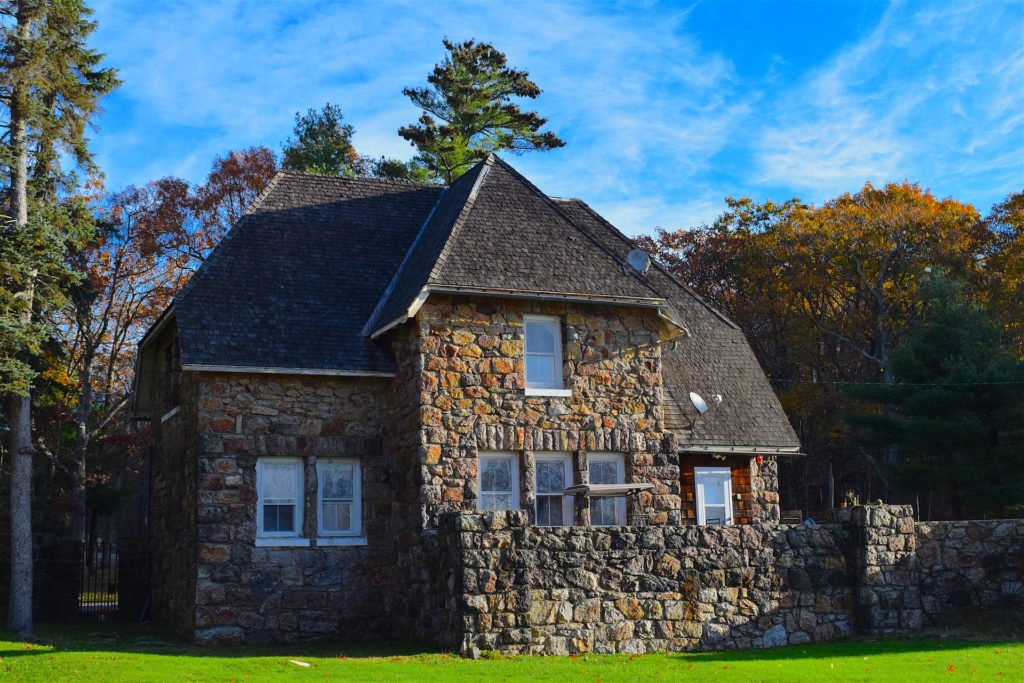
They Don’t Get The Property Inspected
Some old country homes currently on the market are being sold “as is, where is”. But this doesn’t mean you can’t do your due diligence and get a home inspector in there. It just means that if you choose to buy this home, don’t circle back to the Sellers when you find out there is water damage in the basement or rotting beams in the attic.
So doing an inspection is a must. Know exactly what you are getting yourself into.
An inspector experienced in structural engineering and older homes is key.
They Don’t Get Quotes BEFORE They Buy The House
During your homes inspection, bring in as many tradespeople as you can. The more quotes you have the closer you can get to an accurate estimate on restorations and renovations.
I once had a client stagger 10 different tradespeople into a home to get quotes during an inspection on an older home. We were there for 5 hours. The current owners were not pleased, especially when they did not firm up on the house. Once they knew the costs of repairs it was more than they could handle on this particular project.
They Don’t Have A Back Up Budget
Once you start pulling a home back to its seams, you start to unravel surprises. Unpleasant surprises.
Once these start to pop up, your original budget will start to stretch. When people don’t have a backup or ability to cover these issues, they run into trouble.
Have a budget, and have a backup budget to your budget. As the old saying goes – “It is better to have it and not need it than to need it and not have it”.
Being handy here may come in… handy. If you can do some of the work yourself, be it painting or flooring (or something more experienced) you’ll save money. Not time but money.
They Are Not Passionate About Older Homes
If you are only buying an older home that needs work because the list price is lower than the next best comparable. Or because you think you can get a great deal – I would advise not doing it.
Even if you complete the renovations without issue, the home will still have quirks and squeaks that may annoy you. A foundation that probably lets in water from time to time, unlevel floors and drafty rooms.
But if you adore the old style architecture, the character of the home and don’t mind the old quirks you should be fine.

Read up as much as possible on living in older homes. Speak to real estate agents and architects and try to understand fully what you are getting yourself into.
This project has to be close to your heart. It could be a family home, a home for you and a loved one to enjoy or you could be putting your heart and soul into the renovations to sell the home onto a family. Whatever the case may be, loving older homes is a must.

Old Country Home Renovations – Is It Worth It?
The Pros and Cons of Old Country Homes Renovations
I have been hooked on a BBC TV series recently – Restoration Homes. For those of you that haven’t seen it, it’s an excellent show where brave Brits buy run down, historic buildings and turn them into stunning homes for their family.
The transformations of these barns, churches and even castles is definitely an exciting
Sometimes people don’t realize what they are getting into. Restoring older homes or buildings doesn’t just mean you’ll be putting in a new kitchen and updating the wall-paper. Older homes often require much more work than that.
It often becomes more of a rehabilitation project than a renovation.
Because here at Land and Title, we focus on Country Homes and Rural Properties, let’s discuss some of the issues you may run into when reviving a century old country home or
Old Home Renovations Are Expensive.
With older homes, there is always a high chance that you will run into unpleasant surprises
Aside from general interior updating, here are some other items that may need replacing:
- Windows. Specifically original windows – can easily have you running into the thousands of dollars, especially if the windows need to be custom made.
- Stone and Brick home may need masonry work and re .
- Roof repair or replacement. This may go beyond old shingles and get into more structure issues with the roof trusses.
- Updating or replacing life support systems.
All of which can add up quickly. And that’s before you even get started on that new kitchen.
Life Support Systems – Live With Them or Update Them?
Life support systems include wiring, plumbing, heating
If the current owner has not updates theses items you may find some unusual life support systems. For example, you may run into old cinder block basement cisterns for water. Boilers, radiators, fireplaces
Insurance companies can take issue with older and outdated life support systems. Often times they will ask for some items to be updated to modern standards which can quickly get costly.
Renovations Can Take Longer Than Expected.
Some of you may be perfectly fine with this.
If the home is habitable, you can fix up and renovate things as you live there.
For others looking to revive an old home, this may not be possible.
Your move-in in date could be months to years away depending on your budget, who you have helping you, what needs to be done and even the weather.
Contractors or your Architect should be able to give you a timeline for the project. However, with unforeseen surprises that can pop up in extensive home renovations, it is wise to budget for a few extra months … just in case.
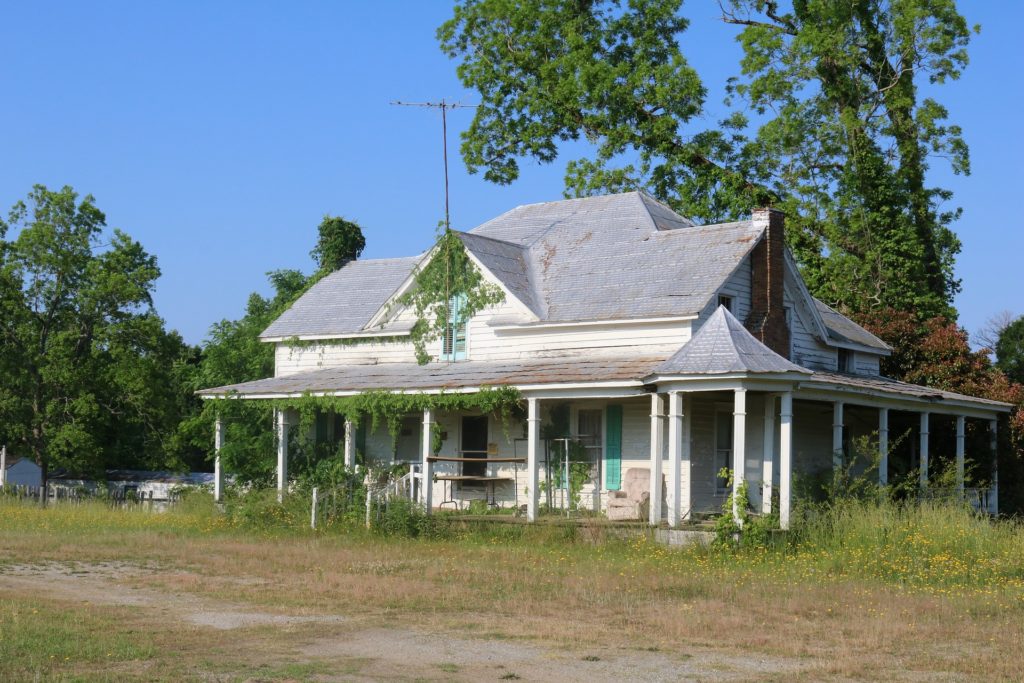
Old Homes That Need Work Can Be Tough To Finance.
Getting financing on a run down or inhabitable building can be difficult. Banks especially don’t like the “as is, where is” text that is sometimes added to listings for old homes that need work.
Even if you are planning to demolish the home. It would likely be valued poorly by an appraiser and banks don’t feel secure lending on these types of properties.
However, it must be said that a property that shows potential value could be considered by A- lenders.
For example, if the home’s exterior was in pretty good shape but just had outdated life support systems and a very dated interior, you might get away with a regular old mortgage.
Although in this case having the home insured may be troublesome.
For those really run down homes, your best hope of getting financing would likely be with a
This issue, of course, doesn’t apply if you are able to finance the entire purchase and project by yourself.
I would be remiss if I didn’t mention some of the great things about living in an old country home.
Unique Homes Can Come From Restorations.
There is a reason people love the idea of living in an old century home or farmhouse.
They have character and charm.
Think stunning post and beam ceilings, Victorian-era style trim, magnificent staircases, cozy rooms
Many of these older homes are built strong – typically made of a solid brick or stone exterior. This may need masonry work but generally, these homes are solid.
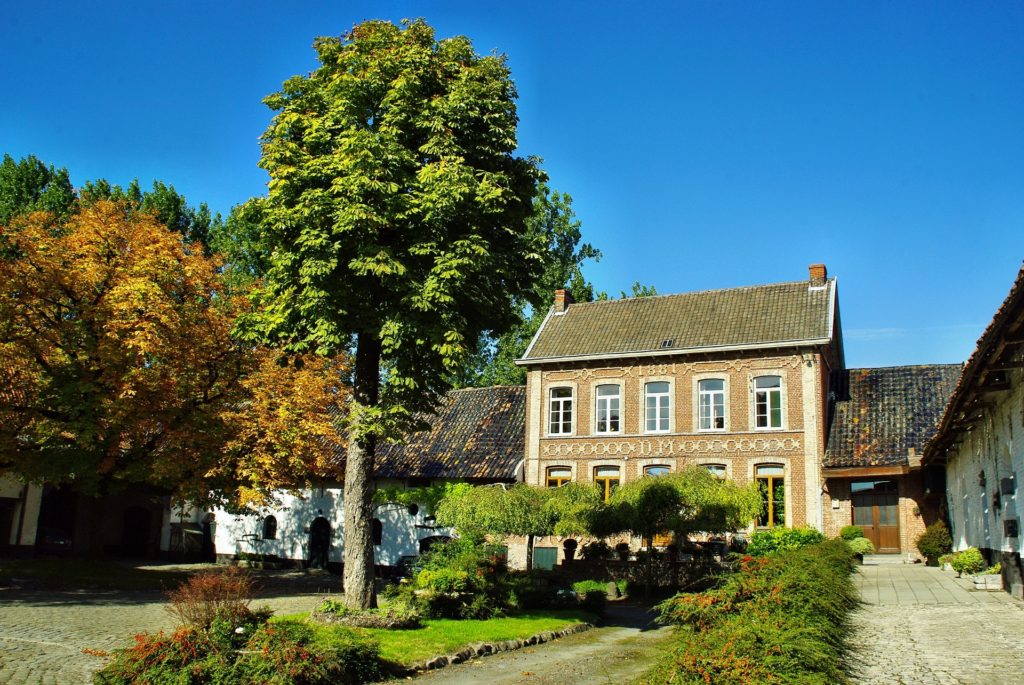
Opting to buy an older home could open up your options in terms of price and the land the home sits on as well.
We have had clients who were willing to work on the home because the house they were buying sat on a gorgeous lot on top of the Niagara Escarpment.
You Might Be Able To Pick Them Up For A Good Price.
Although financing may be an issue on these older homes, you may be able to acquire them for slightly below market value because the home needs work.
But this is a strong “may”.
Nowadays with the lack of inventory and high real estate prices choice has been limited for everyone.
This means more people are willing to take on a project than ever before. And if the home is on an incredible lot, chances are even more people will find it interesting. Even if that means demolishing the current home.
Having said that though, because renovation costs are high as well, you might be in luck at the slightly higher price points. It may not sound like a deal paying for a property that needs work at the $500,000 – $1,500,000 price points but if it was on a 4-acre lot, compared to an updated home on the same lot, you could be getting a deal.
Also, if the home has been listed for some time you’ll hopefully have more negotiating power on the price as well.
If you would like examples of homes that need restoring or homes that have been bought, restored and resold, Please contact me! I will send you real – active and sold – homes in Ontario.
Refinance Your Restoration.
Once the project is completed you may be able to refinance the property with an A lender, putting a new mortgage on your essentially new home.
This can be a little complicated and you should definitely talk to your mortgage broker or financial advisor about your options for after renovations.
Be sure to do this prior to buying the home and have a good plan in place.
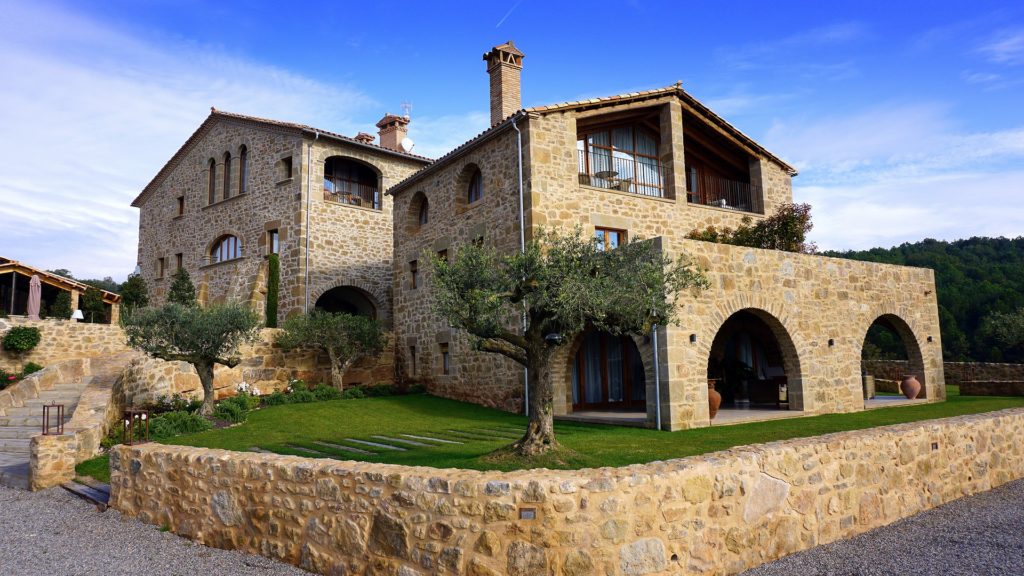
Buying an older home can be intimidating. And it should be. Many people take on the task without truly knowing what they are getting themselves into.
The best thing you can do when buying an older century home or farmhouse is to have a good team in place. Before you put in an offer.
A dream team of good architects, contractors, realtors, home inspectors (versed in century homes) and mortgage brokers are a must have for taking on this kind of project.
Read here for mistakes to avoid when buying and restoring an old century home or farmhouse.
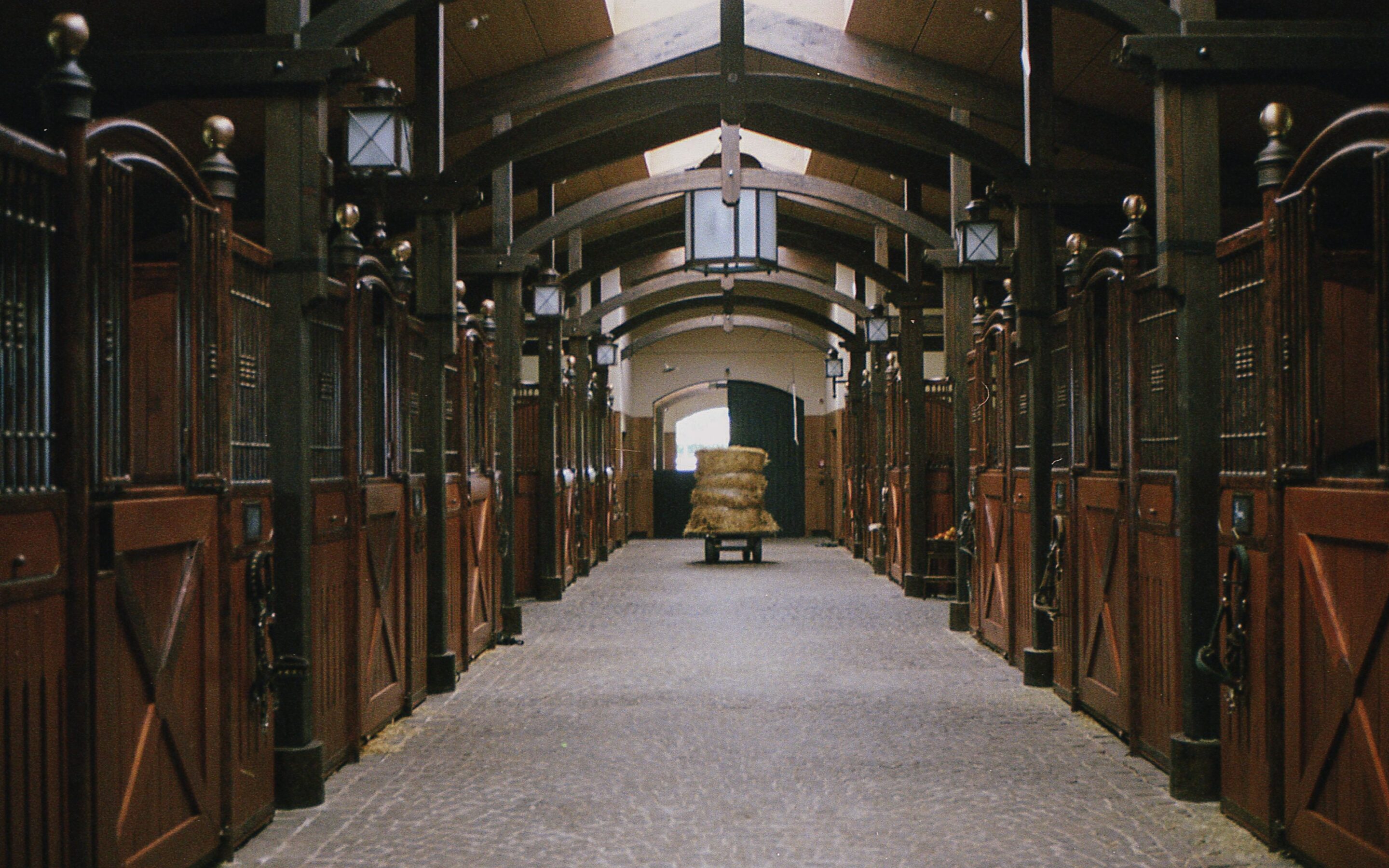
How To Price Your Horse Farm
Pricing a horse farm can be a daunting task. Between current market conditions and the price the seller wants for the property, there are many aspects to getting the right price.
Here are 5 useful tips to help you get to the right price for your equestrian property.
Making Comparisons
The simplest place to start is by comparing your property to similar properties that have sold, and ones that are currently for sale.
In Ontario, there aren’t a ton of horse farms to compare to. However, looking at similarities and making adjustments for any differences between properties will give you an idea of what your property might be worth.
Naturally, you’ll want to find properties that have similar locations, features
Horse properties generally take a while longer to sell than say country homes. So, we feel that looking at comparable properties that have sold between 12-18 months ago are still good comparables to look back on.
Paying close attention to past and current market conditions is extremely important.
Hiring a Professional
You could look into private appraisal companies that specialize in farm appraisals to assist with pricing your property. They generally come in on the lower end of what you might want, but it can be a good place to start.
Alternatively, you can do the right thing and hire an equestrian real estate agent. 🙂
Beyond making detailed and accurate comparisons to other equestrian properties, the right agent is going to understand the intricacies of pricing your horse farm.
We consider the value of the lifestyle that the property offers, what current and future opportunities it presents to buyers and the income it generates (if any).
An equestrian realtor understands the emotional aspects of buying and selling such a property. They will be able to help you navigate through this in the pricing process much more intricately than someone with no or little horse experience.
Pricing Your Location
If we’ve said it once, we’ve said it a million times. The location of a property is extremely important.
Sure, with equestrian properties you aren’t going to have the usual “bad neighborhood” concerns, but location will still have a big impact on price.
What do we know? We all know that the closer you are to Toronto the higher the real estate prices are going to be. If you had the same equestrian facility in the Niagara Region as you did in York region – we can bet that the one in York will have a higher price.
Proximity is important as well. How close are you to horse shows, vets, farriers, other barns, to civilization. These factors and many more play a huge role in buyer and boarder demand.
It all depends on what the buyer is looking for and how your property fits into these needs.
That is to say, if someone is looking to run a show jumping training barn out of the facility – they’ll likely want to be located within a 1-hour radius of Palgrave and Angelstone. On the other hand, if someone is looking for seclusion and a place to keep a couple of retired horses, proximity to civilization isn’t as important.
If you haven’t read it, our equestrian real estate guide is an excellent tool for comparing properties and prices across many regions in Ontario. Get it here.
Price and Property Type
Naturally, the type of horse farm you are selling is going to play a role in how you price the property.
A large boarding and training facility is going to be priced differently from a standardbred racing stable and even more so from a small hobby farm.
With an income producing property, numbers will play a huge role in price.
Aside from valuing the facility itself and the future opportunity it may offer a buyer, you’ll need to take into account how much money the facility brings in on a monthly basis and price accordingly.
On the other side of the spectrum, a small hobby farm most likely won’t have the same facilities as a working barn show will. And so the land and existing residence may play the primary role in valuing the overall property instead.
Adding Value to Get The Price You Want
If your horse farm already has something unique to it that would add value to a buyer and their horses, then this is something that will need to be accounted for in price.
It could be anything from the classic wood railed fencing, a conditioning track, an over-sized indoor area, a
If you don’t think you have a stand-out feature then think about how you can add value to your horse farm to warrant the price you want to ask buyers to pay.
Little things go a long way.
Ask yourself the following: could your property (home and or barn) use some paint, do the fences need repairing, does the driveway look in bad shape, could you prim up the front yard a little with some mulch and flowers? Even updating items like light fixtures, door locks and faucets can improve the look of a property.
Another strategy is to think about what your property could be used for in the future.
Take this scenario as an example – you have a lovely property, a little barn, some paddocks, a home on the property but no indoor arena. If it were me, I would check in with the local municipality for permission on the possibility of building an indoor arena. Obtaining this permission could add value to potential buyers. It expands your buyer pool to those buyers who need an indoor arena as well. Sure, you may not fetch the same price for your property as though it had an indoor arena, but offering up this information can be a great selling feature.
Read onto the second series for tips on getting your property ready for sale.
